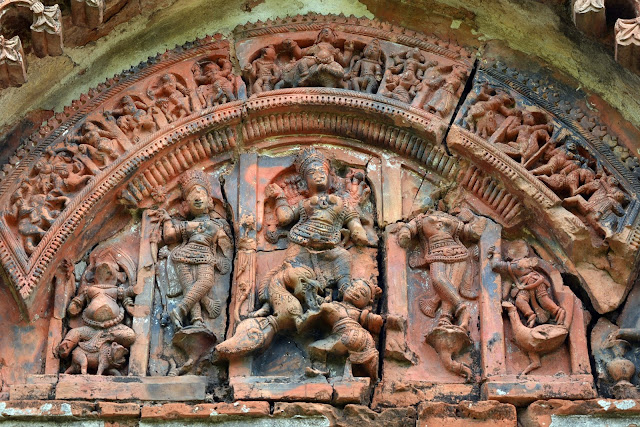Demolition by Neglect : Pancharatna Ratneswar Shiva Temple, Murshidabad
‘Demolition
by neglect’ is the term we can safely use to describe our attitude toward nation’s
historical and cultural heritage. Barring a few historical sites, many lie
neglected in different corners of our beautiful country. We willfully allowed
many of our heritage buildings to crumble.We
recently had a chance to visit the 18th century Pancharatna Ratneswar Shiva
temple, the experience saddened me. The once beautiful temple at Bhattabati
(Bilbari village) under Nabagram Tehsil of Murshidabad district, West Bengal
today is practically in ruins. Two thoughts simultaneously struck me that how painstakingly artisans created this wonderful structure and how easily we left it to crumble.
According to legend, around 1200 Bhatta Brahmin families from Karnat of Southern India came to settle down at Bhattabati. That was the time of Sultan Alauddin Husain Shah (1494-1519 AD). Hence the place got its name as Bhattabati or the home of the Bhattas.
According to legend, around 1200 Bhatta Brahmin families from Karnat of Southern India came to settle down at Bhattabati. That was the time of Sultan Alauddin Husain Shah (1494-1519 AD). Hence the place got its name as Bhattabati or the home of the Bhattas.
The
Ratneswar Shiva Temple is believed to have been built during the early 18th
century when the second Qanungo (कानूनगो) of Bengal Joy Narayan (जय नारायण /জয় নারায়ন), used to live here at Bhattabati.
This
Pancharatna (five pinnacles) Shiva Temple with exquisite terracotta carvings is
possibly the most beautiful temple in this district and can easily be compared
favourably with other terracotta temples of West Bengal. The temple faces south
and measures 8.75 square meters at the base. The temple plinth itself is
4.87×4.90 m. It's height is about 10 meters. The rectangular space between the
first and second arch is beautifully ornamented all round the borders with a variety
of mythological scenes.
The
entire facade of the temple is split into two by beautifully carved series of
'mangalghats' set vertically above one another. The second arch is an
over-hanging cornice supported on nine twin tigers standing on their hind feet.
The smaller arch above supports a series of 24 tiny panels depicting the
Dasavatara flanked by ‘ganas’ Narada, Kali . . . etc. The arches up to the second
tier are flanked on either side by a series of vertical panels (total 14).
Those on the right show incidents from the Krishna myth while on the left are
scenes from the Ramayana.
On
the western facade there is a lovely, but damaged, panel depicting Mahisasura
Mardini with Lakshmi, Saraswati, Kartick and Ganesh. The carvings on the temple
walls are truly magnificent and are examples of Rasalila, but in real bad shape. The panel depicting the myth of Vamana Avata, where Lord Vishnu
incarnates himself as a dwarf priest in this world is dilapidated, partly broken.
The
temple is listed as a protected monument with Archaeological Survey of India,
but no conservation activity can be seen. One can see only a signboard. The ramshackle condition of the temple reminded me again that we don’t
value our heritage, we simply don't care. We forget that our heritage is a part
of our identity. Heritage brings meaning to people through places, objects and
practices, and enhances community engagement and well-being.
What
is urgently needed is a system of managed heritage protection rather than
managed destruction, with all levels of government—local, state, and
federal—working together with local community, because local community is the
first custodian and has the right and responsibility to preserve and maintain
our heritage and ensure that it is not destroyed through neglect.










Comments